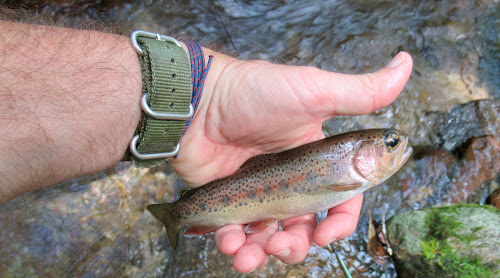
In the Mountain west there are a lot of areas with native wild trout, but the east is a bit different. The mountains are lower, the temps are warmer and the headwaters are much smaller. We have native wild trout but this all results in them being much smaller. Yeah, you can find bigger beasts hiding out in some deeper pools, but for now I'm focusing on the mainstream trout that are found in most of these areas.
Let me set the scene for you. The head waters range from about 2300' to 5000' hight. There are no high mountain valleys as the mountains are old and worn down from millions of years of erosion. The resulting topology is that of streams creased into a network of drainages scattered throughout the Appalachian range. The streams are almost always at the bottom of these V shaped drainages with few flat spots for slow waters. What you find instead are rounded boulders where silt has created pocket water pools spaced up the elevation gain and the banks covered with rhododendron and other plants and trees. As the drainage basin maybe only a few miles from your fishing area, the amount of water contained in these streams is limited (stay out during rainstorms though) to maybe only a few feet across and a few inches to a foot or more. It's here where the native trout live and where you may find yourself fishing.
Kind of a tough spot to fish.There most likely is not a trail that follows the stream so you make your way up the stream working over and around rocks, boulders and logs.
So far so good, now for actually fishing.
The same general rules apply for where the fish can be found. Deeper pools (1-3' deep), below the inflow channel and behind rocks and misc alcoves. All well and good but there may only be a few fish in each pocket water section and they can see you and can swim real fast. You may only get 1 or 2 casts for a section before spooking the fish and either moving on or waiting 10-15 minutes for them to settle down.
As the water is shallow and clear, the fish can see you real well. The fish will see you well before you see them. You may only see them as a shadow that traverses the water to disappear out of view before your first cast.
I've used my 10' Tenkara rod and my 7'6" 3wt rod in these sections. My needs fall between these two. I like my Tenkara rod but need to shorten the line quite a bit. I just need to get the reach to cast into the next upstream pocket.
On the other side, there are many times I'm behind a tree or rock and don't need the long reach but upstream cast to hit my target. In the end, I find that most of the time I've spooked the fish and when I do get lucky, it's unexpected. I've found a pocket where the fish either does not see me or is in hiding. But it's nice to be lucky once in a while.
I've got my eye on another headwater section but I'm waiting for fall to clear out some of the side vegetation. I've been there before (very few people even go up there, let alone fish) and I know there are fish there, now to catch them.

Comments
Post a Comment